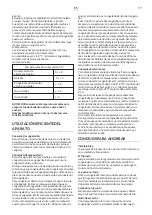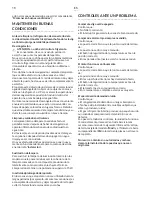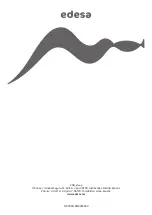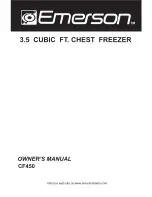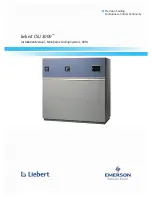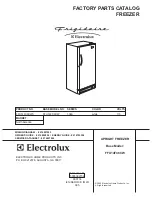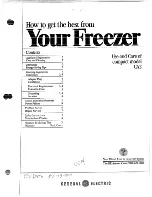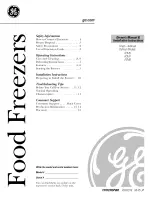
SAFETY
___________________________________________
ATTENTION
Read your manual carefully since it con-
tains instructions which will ensure safe
installation, use and maintenance of your
appliance.
Your appliance is built to International
safety standards (2014/35/EU).
It also meets the EC standards on the pre-
vention and elimination of radio interfer
-
ence (2014/30/EU).
- Keep this manual as a reference for
future use.
- The manufacturer reserves the right to
modify the characteristics of the models
without prior notice.
- Some models may not have all the acces-
sories indicated.
Warning: this appliance must be earthed.
1.
This appliance is designed to be used
indoors and under no circumstances should
it be installed outside, even if protected by a
roof. Leaving the appliance exposed to the
rain and weather is exceedingly dangerous.
2.
This appliance is not intended for use by
persons (including children) with reduced
physical, sensory or mental capabilities, or
lack of experience and knowledge, unless
they have been given supervision or
instruction concerning use of the appliance
by a person responsible for their safety.
Children should be supervised to ensure
that they do not play with the appliance.
3.
Do not attempt to operate or handle this
appliance when barefoot, or with wet
hands or feet.
4.
It is highly recommended that you do not
operate this appliance by connecting it to
the power supply with extensions or multi
-
ple socket plugs.
If the appliance has been installed between
two cabinets, make sure that the supply
cord is not dangerously crimped or trapped
beneath a heavy object.
5.
Never pull the cable or the appliance to
remove the plug from the socket; this is
exceedingly dangerous.
6.
Do not touch the internal cooling
elements, especially if your hands are wet,
since you could burn or hurt yourself. Do
not place ice cubes straight from the freez-
er into your mouth as this may result in
burns.
7.
Before doing any cleaning, disconnect
the appliance from the electricity (by pull-
ing out the home).
8.
Before disposing of your old appliance,
remember to break or remove the lock as a
safety measure to protect children who
might lock themselves inside the appliance
when playing. In addition, if the appliance is
a new one with a lock, keep the key out of
the reach of small children.
9.
If your appliance is not operating proper
-
ly, read the chapter entitled, “
Trouble Shoot-
ing
”, which might help you resolve the
problem. Do not attempt to repair the
appliance by tampering with the internal
components.
10.
If the supply cord is damaged, it must
be replaced by the manufacturer, its service
agent or similarly qualified persons in order
to avoid a hazard.
11.
Do not use electric appliances inside
the food storage compartments of the
appliance, unless they are of the type
recommended by the manufacturer.
12.
Do not use mechanical devices or other
means to accelerate the defrosting process,
other than those recommended by the
manufacturer.
13.
Do not store explosive substances such
as aerosol cans with a flammable propellant
in this appliance.
14.
This appliance is intended to be used in
household and similar applications such as:
- Staff kitchen areas in shops, offices and
other working environments;
- Farm houses and by clients in hotels,
motels and other residential type environ
-
ments;
- Bed and breakfast type environments;
- Catering and similar non-retail applica-
tions.
15.
At the end of the functional life of your
appliance containing cyclopentane gas in
the insulation foam and perhaps R600a gas
(isobutane) in the refrigeration circuit - it
should be made safe before being sent to
the dump. For this operation, please con
-
tact your dealer or the Local Organisation
in charge of waste disposal.
16.
Do not damage the refrigeration circuit.
17.
Keep ventilation openings, in the appli
-
ance enclosure or in the built-in structure,
clean and clear of obstruction.
Fuse replacement
If the mains lead of this appliance is fitted with a BS
1363A 13 amp fused plug, to change a fuse in this type
of plug use an A.S.T.A. approved fuse to BS 1362 type
and proceed as follows:
1.
Remove the fuse cover and fuse.
2.
Fit replacement 13A fuse into fuse cover.
3.
Refit both into plug.
Important: The fuse cover must be refitted when
changing a fuse and if the fuse cover is lost the plug
must not be used until a correct replacement is fitted.
Correct replacement is identified by the colour insert or
the colour embossed in words on the base of the plug.
Replacement fuse covers are available from your local
electrical store.
Connection to a rewireable plug
If the fitted plug is not suitable for your socket outlet,
then is should be cut off and disposed of in order to
avoid a possible shock hazard should it be inserted into
a 13A socket elsewhere. A suitable alternative plug
should then be fitted to the cable. The wires in this
mains lead are coloured in accordance with the follow-
ing code; BLUE - neutral (“N”) BROWN - live (“L”)
GREEN AND YELLOW - earth (“E”)
1.
The GREEN AND YELLOW wire must be connected
to the terminal in the plug which is marked with the
letter “E” or by the Earth symbol or coloured green or
green and yellow.
2.
The BLUE wire must be connected to the terminal
which is marked with the letter “N” or coloured
black.
3.
The BROWN wire must be connected to the
terminal which is marked with the letter “L” or
coloured BROWN or RED which is connected to
the fuse.
INSTALLATION
___________________________________________
To ensure that the appliance operates properly and to
reduce energy consumption, it is important that the
appliance is installed correctly.
Ventilation
The compressor and condenser generate heat and,
therefore, need to be ventilated properly. Rooms with
no ventilation are not suited for installation of the
ppliance. Therefore, it should be installed in a room with
an opening (window or French window) that provide the
appropriate amount of air re-circulation. It is also
important to install it in a free humidity room.
During installation, make sure not to cover or obstruct
the grates that allow for proper ventilation of the
appliance.
For proper ventilation of the appliance, leave a space of
at least 10 cm between the sides of the appliance and
any adjacent cabinets/walls.
Away from Heat
Avoid positioning the appliance in a place where it is
directly exposed to sunlight or near an oven, cook top or
the like.
Electrical and Earth Connection
The appliance should not be turned on right after
transportation. Two hours is the advised time so that
the oil from the motor-compressor gets back to its
original position. Before proceeding with the electrical
connection, make sure that the voltage indicated on the
rating plate, corresponds to the mains voltage in your
home and that the socket is fitted with a standard earth
wire in accordance with safety standards. If the socket
is not fitted with an earth wire, the manufacturer will
not be held liability for any damages and or injuries
arising out of the use of the appliance. Do not use
multiple sockets or adapters. Position the appliance in
such a way that you can access the socket where it is
plugged in.
Electrical power
The electrical socket must be able to handle the maxi
-
mum power load of the appliance, which is indicated on
the rating plate located in the back of the appliance.
THE APPLIANCE
___________________________________________
A -
Temperature adjustment knob
By turning the knob from setting
Min (1)
to setting
Max (4/5)
allows adjusts the temperature inside the
freezer.
B -
Warning Indicator
(red light)
When this red warning light comes on for a prolonged
period of time, it means that the freezer is not function
-
ing properly and the temperature is too high.
This warning light may come on for a brief period when
the door is left open for an extended period of time
(when the freezer is being loaded or unloaded).
C-
Power supply indicator
(green light)
The green light will come on and stay on while the
appliance is connected and is operating normally.
D -
Fast freeze indicator / Running compressor
indicator
(orange light)*
This yellow indicator light will come on when the
Temperature adjustment knob is turned to the “Super”
position
E
(if present).
Models without “Super” function, this light (if present)
comes on while compressor is running.
E -
The freezing position
*
The position “Super”, allows the compressor to function
continuously in order to reach the necessary tempera-
tures for the rapid freezing of fresh food. When the
push button is not pressed, the freezer is functioning
according to the thermostat regulation.
F -
Internal light*
G -
Defrost water drain system*
H -
Basket *
I -
Ventilating grille
J -
Wheels or feet (depending on model)
* - Not present in all models
SETTING UP THE APPLIANCE
___________________________________________
Before starting the appliance, follow the installation
instructions (see “
Safety
” and “
Installation
”).
Once the appliance has been connected to the power
source, the green “
C
” and red “
B
” lights will turn on.
Activate the fast freeze function “Super” (if present) by
turning the “
E
” control to the position “Super” (the
yellow “
D
” (light will turn on).
When the red “
B
” light turn off, turning off the “Super”
(if present), the tellow “
D
” light will turn off and change
the setting by turning the temperature adjustment knob
“
A
”, to the one of the medium settings. At this point the
freezer can be used.
The termostat should be adjusted for the different
types of use as shown in table above.
The instructions presented on the internal lid / conser
-
vation time (months) are only applied for ≤ -18 °C / food
freezer and three-stars storage temperature.
NOTICE: Use average temperature settings to ensure
optimum performance and to save energy.
Some models may not have all the functions described.
EFFICIENT USAGE OF THE
APPLIANCE
___________________________________________
Tips on freezing
Remember that you should never refreeze products you
have allowed to thaw, even if only partially. Once
thawed, cook the food, then either eat (within 24 hours)
or refreeze it.
Tips on packaging
For the best storage and thawing, remember to freeze
small portions. This will ensure rapid and uniform
freezing.
Mark package with a description of the contents and
the date it was frozen. Never freeze more food than
that allowed by the maximum freezing capacity indicat
-
ed on the data plate which is located on the back of the
freezer.
To freeze food, make sure that the red light is off. Then
place the food to be frozen into the freezer, making sure
that it is placed, to the furthest extent possible, in direct
contact with the side walls of the deepest part of the
freezer and not in contact with food that has already
been frozen. Proper storage depends on the speed at
which the food is frozen. For this reason, we recom
-
mend that the switch should be turned to the “Super”
E
(if present) setting 24 hours before the food to be
frozen is placed inside the freezer.
Avoid opening the freezer door during the freezing
process.
Placing substantial amounts of fresh food in the appli
-
ance may temporarily raise the temperature within the
freezer (the red light may turn on). Since this is a
temporary situation, it will not compromise the storage
of the food that has already been frozen.
Attention
: Do
not forget to change the temperature setting if you
want to avoid useless wastes of energy.
In the case of power failure or breakdown, do not open
the freezer door. This will help maintain the tempera
-
ture inside the freezer, ensuring that the goods are
conserved for at least 20 hours.
Do not place full bottles in the freezer because liquids
increase in volume when they freeze and this could
cause the bottles to burst.
Tips on storage
For best storage of fresh-frozen and frozen foods, do
not set the thermostat knob below
Min
, regardless of
the ambient temperature of the room where the freezer
is installed.
For ambient temperatures of up to 25°- 27°C, the
thermostat knob should be set between
1
and
2
, while
for temperatures up to 32°C the setting should be
between
2
and
3
.
Follow the instructions on the packages of frozen foods
scrupulously.
If none are provided, do not store the food for more
than 3 months from the date of purchase.
When purchasing frozen food, make sure that they have
been stored at the proper temperature and that the
package is properly sealed. When purchasing frozen
foods, it is best to transport them in appropriate
containers to keep them cold and then place them in the
freezer immediately.
If the package is damp on the outside or is abnormally
swollen, it is likely that the package was stored at an
inadequate temperature and the food has deteriorated.
ENERGY SAVING
___________________________________________
Install the Appliance Correctly
This means that the appliance should be installed away
from sources of heat or direct sunlight, in a well venti-
lated room.
Correct Temperature Settings
Set the freezer temperature knob to one of the medium
settings. Very low temperatures will not only consume a
great deal of energy, but will neither improve nor
lengthen the storage life of the food.
Shut the Doors
Open your appliance only when strictly necessary –
every time you open the door most of the cold air will be
lost.
In order to restore the correct temperature, the motor
will have to run and consume energy.
Check the Door Seals
Keep the seals clean and pliable so that they fit closely
against the door to ensure that no cold air is lost.
Avoid Frost Build-up
Remember to check the sides of the freezer for frost.
When the frost becomes too thick, defrost the freezer
immediately (See, “
Maintaining the Appliance
”).
MAINTAINING THE APPLIANCE
___________________________________________
Before doing any cleaning, disconnect the appliance
from the electricity (by pulling out the plug or turning
off the general switch in your home)
Defrosting
WARNING: do not damage the refrigeration
circuit.
It is a good idea to remove the frost build up inside of
the appliance from time to time.
Make sure not to use pointed metal objects to do so as
this could result in piercing the refrigeration circuits,
causing irreparable damage to the appliance. Use a
not-pointed tool in plastic material.
To defrost the freezer completely (which should be
done once or twice a year), disconnect the appliance
from the power supply and leave the door open until all
the frost has melted.
The freezer is equipped with a system to drain the
water from the defrosting procedure. Simply, place a
container in the position indicated in figures
1
or
2
. To
speed up defrosting, one or more pots of warm water
can be placed inside the appliance.
While defrosting the freezer, it is a good idea to wrap
the food taken from the freezer in several layers of
paper and place it in a cool place. Since the temperature
of the frozen food will inevitably rise, it is best to
consume it quickly as its storage life will have been
shortened.
Cleaning and Maintenance
The inside of the freezer should be cleaned on a periodic
basis after it has been defrosted. Only use a water and
bicarbonate solution to clean the appliance.
Do not use abrasive cleaning products, detergents or
soap. After the inside has been cleaned, rinse well with
clean water and dry carefully.
Once the appliance has been cleaned, turn on the
appliance, following the instructions in
Setting Up Your
Appliance
.
Changing the inside lamp bulb
To change the bulb inside the appliances that are
equipped with internal lighting, remove the bulb cover
situated on the inside wall of the door by pushing the
ends of thecover indicated in figures
1
or
2
. Replace the
old bulb with a new one of no higher than 15 W.
When not in use
Should the unit not be used for a long period of time (for
example during the summer holidays), disconnect the
plug from the mains and leave the door open to avoid
the formation of mould and unpleasant odours after
completing the defrosting and cleaning operations.
TROUBLESHOOTING
___________________________________________
The green light is off
Check if:
• There is power to the unit;
• The main power switch to the house is on.
The red alarm light is always on
Check if:
• The door is closed properly and the seal is still OK;
• The door is being opened too often;
• The temperature knob is on the right setting;
• There is too much frost build-up.
The motor runs constantly
Check if:
• The freezer is levelled;
• The appliance has been installed between cabinets
that vibrate and make noise;
• It is the noise made by the refrigerant, which occurs
even when the compressor is off (this is not a defect);
If after the checks the appliance still does not operate or
the problem persists, call the nearest Service Centre,
communicating:
type of malfunction, appliance model (
Mod.
) and Serial
Number (
SN
). This information can be found on the data
plate located on the back of the appliance.
Never call on unauthorized technicians and always
refuse spare parts which are not originals.
EN
___
6
Содержание 928271174
Страница 19: ...20 ...

















